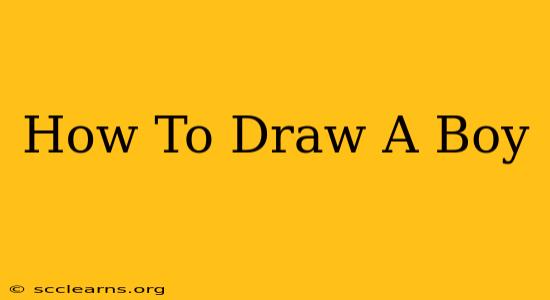So you want to learn how to draw a boy? It might seem daunting at first, but with a little practice and the right techniques, you'll be sketching charming characters in no time! This guide breaks down the process into simple steps, perfect for beginners of all ages. We'll cover everything from basic shapes to adding details and personality. Let's get started!
Basic Shapes: The Foundation of Your Boy Drawing
Before diving into intricate details, start with simple shapes. This is the key to creating a solid foundation for your drawing and helps you understand the underlying structure of the human form.
1. The Head: A Circle or Oval
Begin by sketching a circle or a slightly elongated oval for the head. This will form the basis of your boy's face. Don't worry about perfection at this stage – just get the basic shape down.
2. The Body: Rectangles and Cylinders
Next, use rectangles and cylinders to represent the torso and limbs. Think of the torso as a slightly wider rectangle, and the arms and legs as cylinders connected to the body. Experiment with different proportions to create variations in your boy's posture and build.
3. Connecting the Shapes: Smooth Lines and Curves
Once you have the basic shapes in place, start connecting them with smooth lines and curves. This helps to create a more natural-looking figure. Pay attention to the way the limbs connect to the torso and how the head sits on the neck.
Adding Details: Bringing Your Boy to Life
Now that you have the basic structure, it's time to add details to give your boy drawing personality and realism.
1. Facial Features: Eyes, Nose, and Mouth
Sketch in simple shapes for the eyes, nose, and mouth. Remember, the placement of these features is crucial in determining the boy's expression. Experiment with different eye shapes, nose sizes, and mouth positions to create a unique character.
2. Hair: Lines and Curves
Draw the hair using a combination of lines and curves. Consider the hairstyle – is it short, long, spiky, or wavy? The way you draw the hair will significantly impact the overall look of your drawing.
3. Clothing: Simple Outlines
Add simple outlines for the boy's clothing. Don't get bogged down in intricate details; focus on conveying the basic shape and style of the clothing. Consider adding folds and wrinkles to give the clothing a more realistic appearance.
4. Shoes and Accessories: Personal Touches
Finally, add shoes and any accessories, such as a hat or backpack. These details help to personalize your boy's character and add to the overall appeal of your drawing.
Refining Your Drawing: Shading and Detail
Once you've added all the details, it's time to refine your drawing by adding shading and more details.
1. Shading: Adding Depth and Dimension
Use shading techniques to create depth and dimension in your drawing. This can be done with pencils, charcoal or even digital tools. Pay attention to where the light source is coming from and shade accordingly. This will help to bring your boy to life.
2. Refining Lines: Clean Up Your Sketch
Once you're happy with your shading, go over your lines to clean up your sketch. This step helps to create a finished, polished look.
Practice Makes Perfect!
Remember, practice is key to improving your drawing skills. Don't be afraid to experiment with different styles and techniques. The more you draw, the better you'll become at capturing the nuances of human form and creating unique and expressive characters. So grab your pencils and paper, and start creating your own amazing boy drawings!
Tips for Drawing Boys of Different Ages
- Young Boys: Emphasize larger heads, rounder features, and shorter limbs.
- Teenagers: Show more defined features, taller proportions, and potentially more angular shapes.
This comprehensive guide helps you understand how to draw a boy, from basic shapes to adding personality and details. Remember to practice regularly and have fun! You'll be amazed at how quickly your skills will improve.

